INTRODUCTION
Diabetes, a chronic medical condition, presents in at least three identifiable variations: type 1, commonly detected during early life, arises from faulty β-cells in the pancreas, leading to insufficient insulin secretion due to an autoimmune response; type 2, the prevalent form, is closely associated with dietary habits and lifestyle; gestational diabetes emerges during pregnancy [1]. Type 2 diabetes (T2Ds) alone is estimated to comprise over 90% of all cases. Consequently, exploring preventive measures, curative treatments, or interventions to slow disease progression has become a focal point for the scientific community [2].
The global prevalence of diabetes is escalating. It was reported that approximately 415 million adults had diabetes in 2015, with projections indicating a surge to 642 million by 2040 [3]. More than 80% of individuals diagnosed with type 2 diabetes mellitus reside in developing countries, and this percentage is growing each year [4]. The majority of this projected increase is expected to impact the economically active age group of 45–64 years old, in contrast to many developed countries where the rise in diabetic cases will primarily occur among individuals younger than 65 years old [5].
The shortcomings of existing diabetes treatments have resulted in 2–3.6 million Americans turning to complementary and alternative medicine (CAM) for managing their diabetes. Within the realm of CAM therapy, the majority of research has concentrated on herbs and dietary supplements [6]. Patients often find it highly acceptable to incorporate herbal remedies into their medical interventions. This acceptance stems from the perception that herbal interventions are natural and may have been ingrained in the culture for generations [7].
Numerous natural compounds have been documented to exhibit antidiabetic agents [8], for example, Nigella sativa [9]. Nigella sativa, often known as black seed or black cumin, belongs to the Ranunculaceae family. This herb has garnered attention due to its extensive historical and religious significance, and recent research has unveiled its diverse range of pharmacological benefits [10]. Black cumin is rich in active compounds including polyphenols, flavonoids, saponins, and alkaloids [11]. Thymoquinone (TQ), present in N. sativa, exhibits diverse pharmacological effects in experimental research, such as properties that protect neurons, combat cancer, reduce inflammation, lower blood sugar levels, alleviate epilepsy symptoms, act as antioxidants and modulation of inflammation [9,12,13]. The study by Tütüncü et al. [14] examined the impact of TQ from N. sativa on inflammation and immune responses in rat liver and kidneys, finding that it significantly reduced inflammation and improved immune function, indicating potential for managing inflammation-related disorder [14]. Meanwhile, Bashir et al. [15] found that a 200 mg/kg dose of N. sativa extract effectively inhibited high-fat diet-induced diabetic nephropathy, hyperlipidemia, obesity, and non-alcoholic fatty liver disease, with results comparable to metformin (250 mg/kg). Additionally, oral administration of BCS extract (400, 200, and 100 mg/kg) successfully reduced insulin resistance and managed diabetic complications by regulating AMP-activated protein kinase (AMPK) expression and addressing oxidative stress [15]. Overall, the approach of using N. sativa to manage diabetes is based on its ability to target multiple mechanisms and provide therapeutic benefits across various aspects of the condition. This underscores its potential as a valuable herbal therapy for diabetic patients.
Several studies have shown that N. sativa is effective in improving the clinical condition associated with diabetes [16]. However, there has been a dearth of bibliometric methodologies employed on this matter. Consequently, a bibliometric investigation into the role of N. sativa in diabetes aims to foster further progress in research. Analytical methods exist to assess the significance of scientific publications within the academic or societal framework, providing an additional viewpoint [17]. Bibliometric analysis involves a systematic examination of original manuscripts within pertinent research domains. It helps monitor current research focal points and overall trends, identifies influential works in the field, and yields clearer and more tangible results [18]. Scopus served as the data source due to its extensive coverage and high credibility [19]. VOSviewer was chosen for its ease of use in visualizing complex data, strong capabilities in bibliometric network analysis, and free availability [20]. Other tools like CiteSpace and HistCite were not considered as VOSviewer offers better ease of use and visualization [21,22]. Bibliometric indicators such as annual publications, citations, author and institution collaborations, and keywords were used to identify research trends and impact [23].
A bibliometric study conducted by Salmerón-Manzano et al. [24] using bibliometric software such as VOSviewer and scientific databases from Scopus provides a comprehensive overview of global research trends on medicinal plants, including their use in diabetes treatment, and identifies frequently studied plants such as ginseng and turmeric, which have strong antidiabetic potential [24]. Meanwhile, Shen et al. [25] used the gCLUTO software and PubMed database to analyze the most active research areas in the literature on traditional diabetes treatments, identifying current trends and emerging research areas. These studies provide important context for understanding how N. sativa as an antidiabetic agent fits within the global research landscape, highlighting the growing interest in medicinal plants and significant contributions from various countries that enrich both the literature and clinical practices in this field. Both studies offer unique contributions to complement the existing literature on plant-based therapies for diabetes.
Bibliometric studies focusing on theoretical aspects aid in understanding publication trends and predicting future directions in specific areas [26]. Therefore, this study presents a pioneering method to quantitatively investigate the antidiabetic agent of N. sativa. It aims to establish links with prior research in this area and suggest directions for future studies.
MATERIAL AND METHOD
Data retrieval and collection
The data regarding N. sativa’s antidiabetic agent were collected from the Scopus database on December 12, 2023. The dataset consists of a wide range of scientific papers, offering comprehensive coverage and suitability for bibliometric analysis [27]. Scopus is recognized as a leading online database for bibliometric research and is the largest global database for abstracts and citations [19,28]. It surpasses Web of Science in size and effectiveness for keyword searches and citation analysis, offering a greater number of articles across various disciplines. Unlike Scopus and Web of Science, Google Scholar lacks stringent quality control, indexing materials from academic websites without quality evaluation, which results in a mix of high and low-quality content, such as blogs and magazine articles [29,30].
The search string used was the following: [TITLE-ABS-KEY (“Nigella sativa”) AND TITLE-ABS-KEY (antidiabetic*) OR TITLE-ABS-KEY (antidiabetes*)]. This string was employed in titles, abstracts, and author keywords to ensure a comprehensive search. Asterisks and quotation marks refined the search accuracy, capturing variations of the keyword “antidiabetic” and ensuring the inclusion of closely related terms [28]. To ensure that the results were high-quality and pertinent, this study implemented specific inclusion and exclusion criteria to refine the search. Inclusion focused on “article” and “conference paper” types of documents [29], with English as the selected language [31], and relevant topics related to the antidiabetic agent of N. sativa. The inclusion criteria focused on articles and conference papers because they are peer-reviewed, ensuring quality, and reliability. Articles provide detailed research findings, while conference papers highlight the latest developments and trends, offering a comprehensive view of the research landscape. English-language articles are more accessible to the global scientific community, facilitating the understanding, and validation of research findings. Additionally, many reputable scientific journals use English, reflecting high research standards. Exclusion criteria involved eliminating duplicated literature, irrelevant content, and non-peer-reviewed documents [29,31]. This process yielded a final selection of 105 references meeting all criteria.
Data extraction and analysis
Figure 1 illustrates the data extraction and analysis process. The bibliometric analysis primarily involves reporting descriptive statistics of retrieved document data through visualization and ranking. The bibliometric review in this study began by exporting the eligible documents in comma-separated values format and transferring them to VOSviewer version 1.6.20 software [32]. This software facilitated the visualization and ranking of the retrieved data, allowing for the creation of bibliometric networks such as countries’ co-authorship, co-citation, and keyword co-occurrence networks and overlay [31,33]. The bubble map visualization illustrates a term or phrase, with the size of each bubble indicating the frequency of co-occurrence. Links between bubbles signify their relationship, while bubbles of the same color belong to the same cluster. Keywords are categorized into specific colors based on their average frequency across all publications [28].
RESULTS AND DISCUSSION
From 1987 to 2023, a total of 234 papers related to the antidiabetic properties of N. sativa were gathered, as shown in Figure 1. However, only 105 papers met the inclusion criteria. These papers originated from 38 countries, involved 327 organizations, and included 519 authors. They received a total of 2,599 citations across 84 journals, averaging 24.75 citations per paper.
Publication trend
The yearly count of publications measures the rate of activity and level of interest in the research domain. Analysis of publications related to antidiabetic agents derived from N. sativa reveals a fluctuating growth pattern from 1987 to 2023 in the core database of Scopus. There was a gradual increase in publications from 1987 to 2010, followed by an accelerated growth rate starting in 2011, with 5 publications. Between 1987 and 2010, there were very few studies, with less than 5 published each year. However, from 2011 to 2023, the annual output showed a fluctuating upward trend. In 2022, there was a peak with 13 publications, and as of 2023, a total of 105 papers related to antidiabetic agents derived from N. sativa have been published. Despite no publications in 2012, research in this field has experienced a significant surge (Fig. 2), indicating a rising scholarly interest and establishing it as an emerging research focus in antidiabetic agents derived from N. sativa. This trend will continue to grow steadily in the future, receiving increasing academic attention.
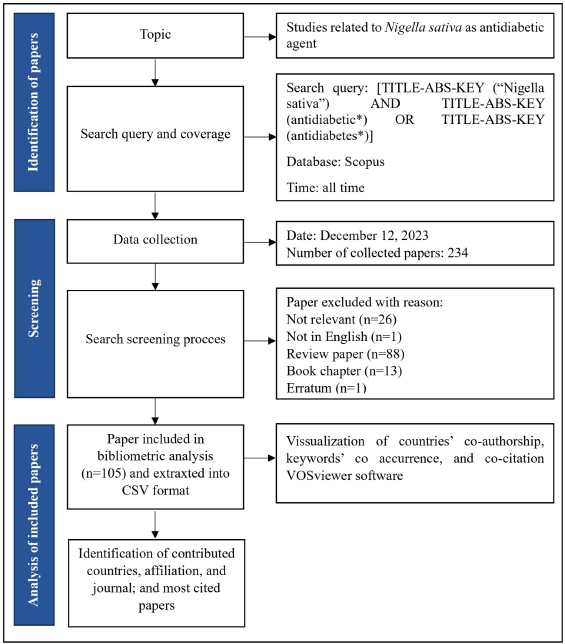 | Figure 1. Flowchart of study methodology: this flowchart outlines the step-by-step methodology employed in the study, detailing the process from data collection through analysis and interpretation. [Click here to view] |
Country collaborative network
Thirty-eight countries researched the antidiabetic agents of N. sativa, resulting in 105 papers selected for this study. The distribution of papers among the top 10 most productive countries in this field is presented in Table 1. Egypt and India lead with 18 papers each, followed by Saudi Arabia with 17 papers and Pakistan with 14 papers. Notably, Egypt and India lead the pack by contributing 17.1% of the publications, significantly more than the other nine countries. In terms of total citations, Egypt holds the top position with 735 citations, followed by Saudi Arabia with 407 citations and Morocco with 367 citations. Morocco also leads in average citation count (45.87), followed by Egypt (40.33) and Malaysia (26.14). These findings suggest that high-quality publications are produced by these three countries. However, the lower average citation rates in Pakistan and Turkey suggest opportunities for enhancing research quality in these countries.
An examination of publications originating from diverse countries yields insights into the significance and impact of each country within a specific research domain. Utilizing VOS clustering, the country collaboration networks were segmented into eight clusters. Notably, while eight clusters represent collaborative networks, countries such as Iran, Iraq, Jordan, Kuwait, and Turkey, do not partake in collaborative efforts with other nations. The allocation of country publications among these collaborative network clusters exhibits significant discrepancies, showing a distinct concentration effect, as most papers originate from scholars in a limited number of countries. Specifically, collaboration between Saudi Arabia and Egypt is more prominent compared to other nations, highlighting the necessity for increased international collaboration to drive progress in the field (Fig. 3).
Contribution by affiliations
More than 250 institutions participated in this study, with the top ten most productive ones outlined in Table 2. Alexandria University, University of Agriculture, and University of Sargodha lead with 5 publications each, followed by Qassim University with 4 publications, and Ain Shams University ranking third with 3 publications. All of the countries with the most productive affiliations are located on the Asian continent. The highest average citation among the most productive affiliations was observed for Aligarh Muslim University with 57.5, indicating that the papers produced by Aligarh Muslim University on this topic are more influential than those from Alexandria University. The varying citation rates among institutions reflect differences in research impact.
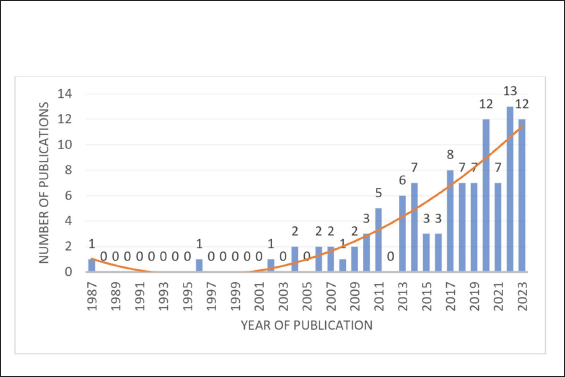 | Figure 2. Publication trends on the topic of antidiabetic agents in N. sativa: this figure presents a graphical representation of publication trends related to antidiabetic agents derived from N. sativa, illustrating the evolution of research interest over time. [Click here to view] |
 | Table 1. The top 10 most productive countries. [Click here to view] |
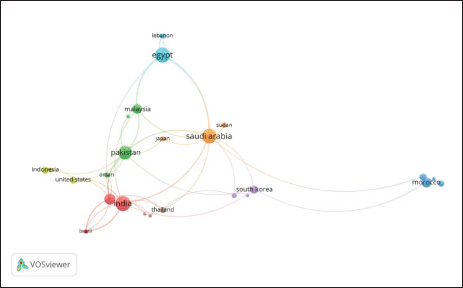 | Figure 3. Network diagram of collaborative relationships between countries: this diagram visualizes the collaborative relationships between different countries in the research on N. sativa, highlighting the extent and intensity of international research collaborations. [Click here to view] |
 | Table 2. The top 10 most productive affiliations. [Click here to view] |
The study applied a threshold of 2, identifying 23 institutions out of the initial 256 that met the threshold criteria. But out of the 23 institutions, only 10 are connected. The co-authorship map of organizational collaboration delineates the collaborative links among the leading 10 contributing institutions, segmented into four clusters employing VOSviewer (Fig. 4). Within these clusters, the University of Sargodha demonstrates the most robust collaborative ties with the Department of Biochemistry, Government College Women University, University of Agriculture, and King Abdulaziz University (with 4 link strength). Followed by Alexandria University (collaborative ties with the Beirut Arab University, and National Research Center) and Ain Shams University (collaborative ties with the King Abdulaziz University, University of Jeddah, and National Research Center) demonstrate the second robust collaborative with three link strengths. Nonetheless, collaborations beyond these clusters appear to be less robust, indicating the necessity for broader collaborative efforts. Strong collaborative ties among top institutions suggest a robust research network, but the limited connections outside these clusters indicate room for broader collaboration.
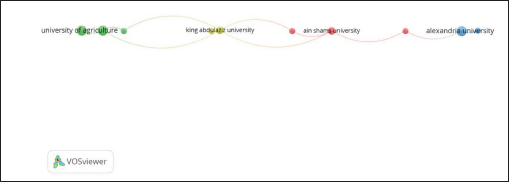 | Figure 4. Co-authorship network of the top 20 corresponding organizations: this figure displays a network diagram illustrating the co-authorship connections among the top 20 organizations contributing to the research on N. sativa, emphasizing their collaborative ties. [Click here to view] |
 | Table 3. The top 10 most productive journals. [Click here to view] |
Contribution by journals
The journals publishing papers on this topic from 1987 to 2023 predominantly fall under the Medicine category, with a few exceptions of comprehensive journals. Table 3 lists the top 10 journals according to publication count related to the antidiabetic agent of N. sativa, citations, and the number of citations attributed to articles from each journal. The most productive journal in this field was the Evidence-Based CAM from Hindawi, with 8 papers and an average citation of 40.3 (the latest paper on the topic of antidiabetic agents of N. sativa was published in 2022). It was followed by the International Journal of Research in Pharmaceutical Sciences and Pakistan Journal of Pharmaceutical Sciences, which published four and three papers, respectively. ACS Omega, International Journal of Biological Macromolecules, Journal of Medicinal Plants, Oxidative Medicine and Cellular Longevity, PLOS One, Biological Trace Element Research, and Journal of Food Biochemistry each published two papers on the topic. Most of the top ten journals with published papers are from journals indexed in the SCR. From the journal analysis, we observed that researchers published their articles in quality journals with good impact factors. Notably, most of the journals where these articles were published are related to antidiabetic agents and CAM, except for PLOS One, which is a multidisciplinary journal.
This information will assist scientists in selecting specific journals and submitting their study reports on this topic to those journals [29]. The Evidence-Based CAM can be considered a targeted journal for the publication of articles on the antidiabetic agents of N. Sativa. An examination of journal citations revealed that Evidence-Based CAM, with a total of eight papers and an average citation of 40.3, has the highest number of articles and the highest average citation, ranking three below PLOS One and Oxidative Medicine and Cellular Longevity. This implies that the journal has attracted considerable interest within this research domain. A review of the published articles reveals that the journal predominantly features empirical research papers centered on CAM.
The map overlay analysis unveiled the global scientific journal network’s pattern, showcasing the interconnection among various journals publishing papers on antidiabetic agents from N. sativa. Among the 84 journals, 53 are linked in the map, forming a comprehensive network (Fig. 5). In this visualization, each node represents a journal, while the color curves represent citation linkage lines, illustrating the paths of citation connections between different journals. This map provides valuable insights into the interconnectedness and flow of scientific information within the research domain of antidiabetic agents from N. sativa.
Analysis of journal co-citation
When two article items are cited together, it indicates simultaneous referencing of both items. The occurrence of simultaneous citations can be utilized to evaluate the similarity and relevance of the articles. Through a detailed examination of the content of various studies, analyses of journal co-citation become feasible.
The research utilized a threshold of 5, resulting in the identification of 73 journals out of the initial 2,500 that met the criteria. By analyzing co-cited literature, a foundational understanding of the field can be constructed, with the research frontier comprising citations within these journals. Figure 6 visually illustrates the network of co-citations among journals, with the Journal of Ethnopharmacology emerging as the most cited and central journal in the network, followed by Diabetes and Diabetes Care. This evidence indicates a strong correlation between research in the field of ethnopharmacology and studies on diabetes. Research-focused trends in ethnopharmacology and diabetes can offer valuable insights into journal citation dynamics, research patterns, and interdisciplinary impacts. This analysis aids in understanding the connection between ethnopharmacological studies and other health-related fields such as pharmacology, toxicology, oncology, and immunology. Comprehensive research in ethnopharmacology can drive innovations in disease prevention and treatment, leading to the development of new, effective, and safe therapies, including those derived from N. sativa for diabetes management.
Keyword co-occurrence network
Keywords are crucial for summarizing focused research in literature, serving as pivotal elements. The frequency of their co-occurrence provides insights into developing trends in mindfulness intervention within the domain of antidiabetic agents of N. sativa. High-frequency keywords illuminate the research’s focal points, innovative methodologies, significant challenges, or notable academic themes within a specific period [34]. A keyword co-occurrence and clustering analysis of 1,468 papers’ keywords, including author keywords and keyword plus, was performed using VOSviewer. Keywords appearing at least 5 times were considered, resulting in 100 keywords meeting the threshold. Figure 7A depicts the network diagram for keyword co-occurrence analysis, incorporating all keywords included in the analysis. Commonly occurring keywords, excluding less relevant terms, encompass terms such as article, blood glucose, controlled study, antidiabetic activity, and black cumin. The clustering and the top 10 related keyword clusters are outlined as follows:
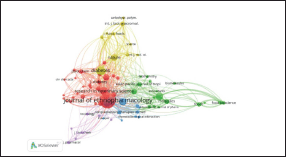 | Figure 5. Global science portfolio pattern on a map of scientific journals: this network diagram analyzes the global distribution of research on N. sativa, mapping the pattern of scientific journals involved in the study of antidiabetic agents. [Click here to view] |
- The medicinal potential and pharmacological effects of N. sativa, particularly in the context of diabetes treatment and its antioxidant properties. (Keywords: Black cumin, human, adult, alanine aminotransferase, aspartate aminotransferase, biochemical analysis, blood, blood sampling, body sampling, and body weight).
- The chemical composition, medicinal properties, and potential therapeutic effects of N. sativa. (Keywords: Nigella sativa, nonhuman, article, antidiabetic activity, Nigella sativa extract, alloxan, amylase, antioxidant activity, benzoquinones, chemistry, and drug activity).
- The research extensively studies the therapeutic potential of N. sativa for diabetes and associated complications. It examines the effects of N. sativa oil on diabetic neuropathy, blood sugar, and lipids in T2D, its efficacy in high-fat diet mouse models, and its comparison with treatments such as vitamin E and metformin. (Keywords: Controlled study, animal experiment, catalase, gene expression, histopathology, immunochemistry, insulin blood level, insulin release, lipid peroxidation, and malonaldehyde).
- The research investigates N. sativa’s impact on glycemic control, lipid metabolism, its comparative efficacy with vitamin E and metformin, its effects on diabetic neuropathy and nephroprotection, and its mechanisms of action concerning insulin resistance, gut microbiota, and oxidative stress. (Keywords: Glucose blood level, dose response, drug mechanism, insulin resistance, insulin sensitivity, Nigella sativa oil, and plant oils).
- The research thoroughly examines N. sativa, including its effects on diabetes animal models, insulin secretion, blood glucose, and lipid profiles. It aims to uncover underlying mechanisms such as AMPK activation and increased muscle Glut4 content. (Keyword: Oral glucose tolerance test).
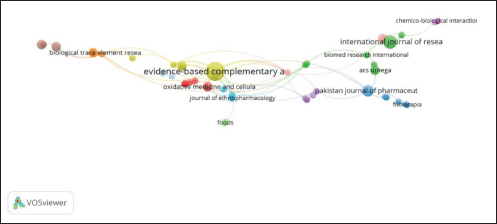 | Figure 6. Journal co-citation analysis from 1987 to 2023: this network diagram shows the co-citation relationships between journals over the years, highlighting the interconnectedness and influence of key journals in the field. [Click here to view] |
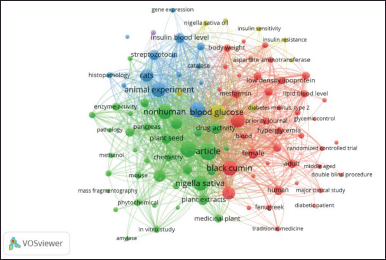 | Figure 7 A. keyword visualization map: this map visualizes different research themes and clusters by color-coding keywords related to N. sativa, indicating distinct areas of focus within the research literature. [Click here to view] |
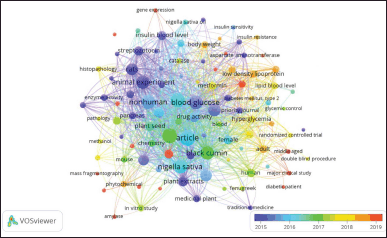 | Figure 7 B. Overlay map of keyword co-occurrence and clustering: this overlay map depicts the co-occurrence and clustering of keywords, providing insight into the evolving research themes and methodologies from 1987 to 2023. [Click here to view] |
The timeline analysis offers a historical perspective by positioning keywords on the axis according to their occurrence in the literature. Node size corresponds to frequency, while node color represents the timeframe. This visualization illustrates the evolution of keywords over time. As depicted in Figure 7B, from 1987 to 2015, studies on the antidiabetic agents of N. sativa, have highlighted several significant areas. These include investigating its impact on blood glucose levels, understanding its mechanisms of action in diabetes treatment, evaluating its role in managing diabetes-related complications, and assessing its therapeutic benefits in experimental diabetes models. Additionally, research has delved into its immunomodulatory [35] and anticancer effects [35,36]. Furthermore, investigations employing network pharmacology and animal cell experiments suggest promising avenues for continued advancement in this field, both presently and in the future. From 2015 to 2019, researchers conducted systematic and in-depth studies on N. sativa, focusing on various aspects such as its antidiabetic agents identified through techniques like GC-FID. Mechanistic studies delved into factors such as antioxidant activity, antimicrobial activity, and effects on endothelial dysfunction in diabetes mellitus [37]. Between 2019 and 2023, research has shown N. sativa’s potential in diabetes management by reducing oxidative stress, inflammation, and improving lipid profiles [38]. Key findings include the effectiveness of TQ, seed extracts in blood glucose regulation, and the benefits of N. sativa nanoparticles [39]. These studies highlight N. sativa as a promising supplementary therapy for diabetes. The evolution of keyword trends over time indicates shifts in research focus, from basic pharmacological studies to more complex investigations into mechanisms and clinical applications. This evolution points to expanding research frontiers and emerging areas for future exploration.
Future research on N. sativa should focus on several key areas to enhance its therapeutic potential for diabetes management. First, further investigation into the mechanisms by which TQ exerts its immunomodulatory and anti-inflammatory effects is crucial, particularly regarding its impact on liver and kidney function [40]. Expanding studies on the efficacy of N. sativa seed extracts in diverse patient populations and clinical settings will provide a broader understanding of its benefits. Additionally, exploring the use of N. sativa nanoparticles and their synergistic effects with other substances could reveal new avenues for improving antidiabetic and antioxidant activities [41,42]. Long-term studies assessing the safety, efficacy, and optimal dosage of N. sativa in combination therapies will also be essential. Finally, integrating network pharmacology and advanced analytical techniques to uncover novel pathways and interactions will help refine therapeutic strategies and expand the clinical applications of N. sativa in diabetes management.
CONCLUSION
This study provides a comprehensive bibliometric analysis of research trends related to the antidiabetic agent of N. sativa from 1987 to 2023. With 105 papers meeting the inclusion criteria, this analysis reveals a significant increase in research activity over the years, particularly since 2011, highlighting the growing academic interest in this field. The study also emphasizes the critical role of international collaboration, with countries such as Egypt, India, and Saudi Arabia leading in publication output and citations. The analysis of affiliations and journals further underscores the importance of publishing in high-impact journals and fostering institutional collaborations to enhance the visibility and impact of research. The co-citation and keyword co-occurrence analyses demonstrate the interdisciplinary nature of research on N. sativa, connecting ethnopharmacology with diabetes research, and highlighting the plant’s potential in managing diabetes through various mechanisms. Overall, this research maps the existing knowledge landscape and identifies key areas for future investigation. The findings emphasize the need for continued exploration of N. sativa’s antidiabetic potential, particularly through advanced analytical techniques and collaborative efforts, to unlock new therapeutic strategies for diabetes management.
ACKNOWLEDGMENT
The authors convey deep gratitude to Universitas Muhammadiyah Surakarta for their invaluable support in facilitating and resourcing this study.
AUTHOR CONTRIBUTIONS
Each author has contributed significantly to the conceptualization and design of the study, as well as to the acquisition, analysis, and interpretation of data. Each author has played an active role in either drafting the manuscript or critically revising it to ensure the inclusion of essential intellectual content. Additionally, all authors have consented to the submission of the manuscript to the current journal, given final approval for the intended publication version, and accepted full responsibility for all aspects of the research. It is confirmed that all authors meet the eligibility criteria for authorship inclusion as stipulated by the guidelines established by the International Committee of Medical Journal Editors.
FINANCIAL SUPPORT
This study was funded by Universitas Muhammadiyah Surakarta through Pengembangan Individual Dosen (PID).
CONFLICTS OF INTEREST
The authors declare no financial or other conflicts of interest in this work.
ETHICAL APPROVALS
This study does not involve conducting experiments on animals or human subjects.
DATA AVAILABILITY
All data produced and analyzed have been incorporated into this research article.
PUBLISHER’S NOTE
This journal maintains neutrality concerning jurisdictional claims related to published institutional affiliations.
REFERENCES
1. Farias TC, de Souza TSP, Fai AEC, Koblitz MGB. Critical review for the production of antidiabetic peptides by a bibliometric approach. Nutrients. 2022;14:4275. CrossRef
2. Henson J, Anyiam O, Vishnubala D. Type 2 diabetes. In: Scott A, Broom D, editors. Exercise Management for Referred Medical Conditions. Taylor & Francis; 2023. pp 223–52. CrossRef
3. International Diabetes Federation. IDF Diabetes Atlas. 10th edition. Brussels, Belgium: International Diabetes Federation; 2021.
4. Galicia-Garcia U, Benito-Vicente A, Jebari S, Larrea-Sebal A, Siddiqi H, Uribe KB, et al. Pathophysiology of type 2 diabetes mellitus. Int J Mol Sci. 2020;21:1–34. CrossRef
5. Wu Y, Ding Y, Tanaka Y, Zhang W. Risk factors contributing to type 2 diabetes and recent advances in the treatment and prevention. Int J Med Sci. 2014;11:1185. CrossRef
6. Medagama AB, Bandara R. The use of complementary and alternative medicines (CAMs) in the treatment of diabetes mellitus: is continued use safe and effective? Nutr J. 2014;13:102. CrossRef
7. Cefalu WT, Stephens JM, Ribnicky DM. Diabetes and herbal (Botanical) medicine. In: Benzie IFF, Wachtel-Galor S, editors. Herbal Medicine: Biomolecular and Clinical Aspects: 2nd edition. Boca Raton, FL: CRC Press/Taylor & Francis; 2011. pp 405–18. CrossRef
8. Chang CLT, Lin Y, Bartolome AP, Chen YC, Chiu SC, Yang WC. Herbal therapies for type 2 diabetes mellitus: chemistry, biology, and potential application of selected plants and compounds. Evid Based Complement Alternat Med. 2013;2013:378657. CrossRef
9. Sutrisna E, Azizah T, Wahyuni S. Potency of Nigella sativa linn. seed as antidiabetic (preclinical study). Res J Pharm Technol. 2022;15:381–4. CrossRef
10. Hannan MA, Rahman MA, Sohag AAM, Uddin MJ, Dash R, Sikder MH, et al. Black Cumin (Nigella sativa L.): A comprehensive review on phytochemistry, health benefits, molecular pharmacology, and safety. Nutrients. 2021;13:1784. CrossRef
11. Kadam D, Lele SS. Extraction, characterization and bioactive properties of Nigella sativa seedcake. J Food Sci Technol. 2017;54:3936–47. CrossRef
12. Khan SS, Zaidi KU. Protective effect of Nigella sativa seed extract and its bioactive compound thymoquinone on streptozotocin-induced diabetic rats. Cardiovasc Hematol Agents Med Chem. 2024;22:51–9. CrossRef
13. Alenezi SK. The ameliorative effect of thymoquinone on vincristine-induced peripheral neuropathy in mice by modulating cellular oxidative stress and cytokine. Life. 2023;13:101. CrossRef
14. Tütüncü ?, Ertu?rul T, Ertekin A, Delice N, Altin E. Immunomodulatory and anti-inflammatory effect of thymoquinone on rat liver and kidneys[Timokinonun rat Karaci?er ve Böbrekleri Üzerindeki ?mmunmodülatör ve Antiinflamatuvar Etkisi]. Vet Sci Pract. 2023;18:95–101. CrossRef
15. Bashir KMI, Kim JW, Kim JK, Chun YS, Choi JS, Ku SK. Efficacy confirmation test of Black Cumin (Nigella sativa L.) seeds extract using a high-fat diet mouse model. Metabolites. 2023;13:501. CrossRef
16. Syuhada, Anggadiredja K, Kurniati NF, Akrom. The potential of Nigella sativa oil on clinical output improvement of diabetic neuropathy. J Appl Pharm Sci. 2023;13:9–17. CrossRef
17. Ulugerger Avci G. A bibliometric perspective to the most cited diabetes articles. J Diabetes Metab Disord. 2023;22:763–73. CrossRef
18. Zhang X, Zhang Y, Hu Y. Knowledge domain and emerging trends in empagliflozin for heart failure: a bibliometric and visualized analysis. Front Cardiovasc Med. 2022;9:1039348. CrossRef
19. Falagas ME, Pitsouni EI, Malietzis GA, Pappas G. Comparison of PubMed, Scopus, Web of Science, and Google Scholar: strengths and weaknesses. FASEB J 2008;22:338–42. CrossRef
20. van Eck NJ, Waltman L. Software survey: VOSviewer, a computer program for bibliometric mapping. Scientometrics. 2010;84:523–38. CrossRef
21. Jan van Eck N, Waltman L. VOSviewer Manual. 2020.
22. Perianes-Rodriguez A, Waltman L, van Eck NJ. Constructing bibliometric networks: a comparison between full and fractional counting. J Informetr. 2016;10:1178–95. CrossRef
23. Aria M, Cuccurullo C. bibliometrix: an R-tool for comprehensive science mapping analysis. J Informetr. 2017;11:959–75. CrossRef
24. Salmerón-Manzano E, Garrido-Cardenas JA, Manzano-Agugliaro F. Worldwide research trends on medicinal plants. Int J Environ Res Public Health. 2020;17:3376. CrossRef
25. Shen H, Zhu WK, Lu Z, Zhou HC. Hotspot analysis of traditional drugs in diabetes treatment literature. Chin J Integr Med. 2021;27:304–12. CrossRef
26. Donthu N, Kumar S, Mukherjee D, Pandey N, Lim WM. How to conduct a bibliometric analysis: an overview and guidelines. J Bus Res. 2021;133:285–96. CrossRef
27. Arifah FH, Nugroho AE, Rohman A, Sujarwo W. A bibliometric analysis to preclinical studies of Tinospora Crispa (L.) Hook. F. & Thomson as An Antidiabetic. Indonesian J Pharm 2023;34:24–35. CrossRef
28. Shakhshir MH, Vanoh D, Hassan M, Zyoud SH. Mapping the global research landscape on malnutrition for patients with chronic kidney disease: a visualization analysis. J Health Popul Nutr. 2023;42:101. CrossRef
29. Sari AA, Munawaroh R, Sofyanita EN. Bibliometric analysis of antibacterial activity of Centella asiatica: a study based on Scopus database. J Appl Pharm Sci. 2023;13:001–15. CrossRef
30. Harzing AW, Alakangas S. Google Scholar, Scopus and the Web of Science: a longitudinal and cross-disciplinary comparison. Scientometrics. 2016;106:787–804. CrossRef
31. Huang W, Wang J, Kuang M, Xiao Z, Fan B, Sun G, et al. Exploring global research status and trends in anti-obesity effects of traditional Chinese medicine through intestinal microbiota: a bibliometric study. Front Cell Infect Microbiol. 2023;13:1271473. CrossRef
32. Abdullah KH, Aziz FSA. mapping of laboratory safety research: a bibliometric review. Malaysian J Public Health Med. 2021;21:303–10. CrossRef
33. Kusuma RR, Widianingsih I, Ningrum S, Myrna R. Five clusters of flood management articles in Scopus from 2000 to 2019 using social network analysis. Sci Ed. 2021;8:85–92. CrossRef
34. Yang H, Shao X, Wu M. A review on ecosystem health research: a visualization based on CiteSpace. Sustainability. 2019;11:4908. CrossRef
35. Hmza AJA, Osman MT, Adnan A, Omar E. Immunomodulatory effect of Nigella sativa oil in the disease process of type 1 diabetic rats. Res J Pharm Biol Chem Sci. 2013;4:980–8.
36. Kadan S, Saad B, Sasson Y, Zaid H. In vitro evaluations of cytotoxicity of eight antidiabetic medicinal plants and their effect on GLUT4 translocation. Evid-Based Complement Altern Med. 2013;2013:549345. CrossRef
37. Demirbolat ?, Kartal M, Karik Ü. Development and validation of a GC-FID method to quantify thymoquinone in black cumin seed oils. Marmara Pharm J. 2019;23:506–13. CrossRef
38. Almatroodi SA, Alnuqaydan AM, Alsahli MA, Khan AA, Rahmani AH. Thymoquinone, the most prominent constituent of nigella sativa, attenuates liver damage in streptozotocin-induced diabetic rats via regulation of oxidative stress, inflammation and cyclooxygenase-2 protein expression. Appl Sci. (Switzerland) 2021;11:3223. CrossRef
39. Hasan Chowdhury MA, Al Araby SQ, Alelwani W, Kattan SW, Mansouri OA, Uddin Rahat MR, et al. Green-synthesized nanoparticles of the polyherbal extract attenuate the necrosis of pancreatic β-cell in a streptozotocin-induced diabetic model. Heliyon. 2023;9:e16137. CrossRef
40. El-Shamy KA, Mosa MMA, El-Nabarawy SK, El-Qattan GM. Effect of Nigella sativa tea in type 2-diabetic patients as regards glucose homeostasis, liver and kidney functions. J Appl Sci Res. 2011;7:1982–91.
41. Shari FH, Ramadhan HH, Mohammed RN, Al-Bahadily DC. Hypolipidemic and antioxidant effects of fenugreek- Nigella sativa combination on diabetic patients in Iraq. Syst Rev Pharm. 2020;11:911–5. CrossRef
42. Akhtar MT, Ilyas HF, Shaukat UA, Qadir R, Masood S, Batool S, et al. Comparative study of hypoglycaemic and antioxidant potential of methanolic seed extract and oil of Nigella sativa on alloxanized diabetic rabbits. Pak J Pharm Sci. 2022;35:1755–60. CrossRef